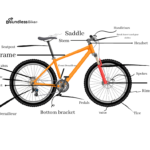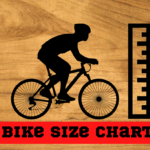When it comes to buying a bike, one of the most important factors to consider is the size of the bike frame. A bike frame that is too small or too large can cause discomfort, pain, and even injury. Therefore, it is crucial to find the right size of the bike frame that fits your body type and riding style.
Bike frames come in a variety of sizes, and the size of the frame is typically measured in inches or centimeters. The size of the frame is determined by several factors, including the length of the seat tube, the length of the top tube, and the height of the bike’s head tube. When it comes to large bike frames, the size can vary depending on the type of bike, such as road bikes, mountain bikes, or hybrid bikes.
For riders who are over six feet tall, a large bike frame is usually the best option. However, it is important to note that the size of the frame is not just about height, but also about the rider’s inseam and arm length. A bike frame that is too large can cause the rider to stretch too far to reach the handlebars, while a frame that is too small can cause the rider to feel cramped and uncomfortable. Therefore, it is important to consider all of these factors when determining the size of a large bike frame.
Understanding Bike Frame Sizes
When it comes to buying a bike, one of the most important factors to consider is the size of the bike frame. A bike frame’s size can have a significant impact on the rider’s comfort, performance, and overall experience. In this section, we will explore the different bike frame sizes for various types of bikes.
Road Bikes
Road bikes are designed for speed and efficiency on smooth, paved roads. The standard frame sizes for road bikes range from 47cm to 63cm. The size of the frame is typically measured from the center of the bottom bracket to the top of the seat tube. However, some manufacturers measure frame size differently, so it’s essential to check the manufacturer’s guidelines before making a purchase.
Mountain Bikes
Mountain bikes are designed for off-road terrain and rough trails. The frame sizes for mountain bikes are typically measured in inches and range from 13″ to 23″. The size of the bike frame is determined by the length of the seat tube and the length of the top tube. The length of the top tube is especially important for mountain bikes because it determines the rider’s reach and how much control they have over the bike.
Hybrid Bikes
Hybrid bikes are a cross between road bikes and mountain bikes, designed for a variety of terrains, including paved roads, dirt paths, and light trails. The frame sizes for hybrid bikes are typically measured in inches and range from 14″ to 23″. The size of the frame is determined by the length of the seat tube, similar to mountain bikes.
Gravel Bikes
Gravel bikes are designed for riding on unpaved roads and gravel paths. The frame sizes for gravel bikes are similar to road bikes, typically ranging from 47cm to 63cm. However, gravel bikes often have a more relaxed geometry, which means they have a shorter top tube and a taller head tube, providing a more upright riding position.
When it comes to choosing the right bike frame size, it’s essential to consider several factors, including the rider’s height, inseam length, and riding style. A bike that is too small or too large can cause discomfort, pain, and even injury. It’s always best to consult with a professional bike fitter or a knowledgeable salesperson to ensure you choose the right bike frame size for your needs.
How to Measure Bike Frame Size
When it comes to buying a bike, one of the most important factors to consider is the size of the bike frame. An ill-fitting bike can lead to discomfort, pain, and even injury. Therefore, it is crucial to measure the bike frame size accurately. In this section, we will discuss the various measurements that you need to take to determine the correct size for your bike frame.
Seat Tube Length
The first measurement to take is the seat tube length, which is the distance between the center of the bottom bracket and the top of the seat tube. This measurement is usually given in centimeters and is the most important factor in determining the size of the bike frame.
Top Tube Length
The top tube length is the distance between the center of the seat tube and the center of the head tube. It is important to measure this length as it affects the reach of the bike.
Reach
The reach is the horizontal distance between the center of the bottom bracket and the center of the head tube. This measurement is crucial as it determines the distance between the saddle and the handlebars.
Stack
The stack is the vertical distance between the center of the bottom bracket and the center of the head tube. This measurement is important as it determines the height of the handlebars.
Head Tube Length
The head tube length is the length of the head tube from the bottom to the top. This measurement is important as it affects the height of the handlebars.
Chainstay Length
The chainstay length is the distance between the center of the bottom bracket and the center of the rear axle. This measurement is important as it affects the handling of the bike.
Bottom Bracket Height
The bottom bracket height is the distance between the ground and the center of the bottom bracket. This measurement is important as it affects the stability of the bike.
Seat Tube Angle
The seat tube angle is the angle between the seat tube and the ground. This measurement is important as it affects the position of the rider on the bike.
Head Tube Angle
The head tube angle is the angle between the head tube and the ground. This measurement is important as it affects the handling of the bike.
Effective Top Tube Length
The effective top tube length is the horizontal distance between the center of the seat tube and the center of the head tube, measured parallel to the ground. This measurement is important as it affects the reach of the bike.
Stem Length
The stem length is the distance between the center of the handlebars and the center of the steerer tube. This measurement is important as it affects the reach of the bike.
Saddle Height
The saddle height is the distance between the center of the bottom bracket and the top of the saddle. This measurement is important as it affects the position of the rider on the bike.
When measuring a bike frame, it is important to take all of these measurements into consideration. Using a bike size chart or a bike frame size chart can be helpful in determining the correct size for your bike frame. Remember, an ill-fitting bike can lead to discomfort, pain, and even injury, so it is crucial to measure the bike frame size accurately.
Sizing Guide for Different Bikes
When it comes to buying a bike, one of the most important factors to consider is the size of the frame. A frame that is too small or too large can lead to discomfort, poor performance, and even injury. Here is a sizing guide for different types of bikes to help you choose the right size.
Road Bikes
Road bikes are designed for speed and efficiency on paved roads. The sizing of road bikes is typically based on the length of the seat tube, which runs from the bottom bracket to the top tube. Here is a general sizing chart for road bikes based on rider height:
| Rider Height | Frame Size |
|---|---|
| 4’10” – 5’1″ | 47 – 49cm |
| 5’1″ – 5’3″ | 50 – 52cm |
| 5’3″ – 5’5″ | 53 – 54cm |
| 5’5″ – 5’7″ | 54 – 56cm |
| 5’7″ – 5’9″ | 56 – 58cm |
| 5’9″ – 5’11” | 58 – 60cm |
| 5’11” – 6’2″ | 60 – 62cm |
| 6’2″ – 6’5″ | 62 – 64cm |
It’s important to note that these are just general guidelines, and other factors such as rider flexibility and body proportions can also affect the ideal frame size.
Mountain Bikes
Mountain bikes are designed for off-road terrain and are typically sized based on the length of the top tube, which runs from the seat to the handlebars. Here is a general sizing chart for mountain bikes based on rider height:
| Rider Height | Frame Size |
|---|---|
| 4’11” – 5’3″ | 13 – 15″ |
| 5’3″ – 5’7″ | 15 – 17″ |
| 5’7″ – 5’11” | 17 – 19″ |
| 5’11” – 6’2″ | 19 – 21″ |
| 6’2″ – 6’4″ | 21 – 23″ |
| 6’4″ & up | 23″ & up |
Again, these are just general guidelines, and other factors such as riding style and terrain can also affect the ideal frame size.
Hybrid Bikes
Hybrid bikes are a cross between road bikes and mountain bikes, designed for a variety of terrain and riding styles. The sizing of hybrid bikes is similar to that of road bikes, based on the length of the seat tube. Here is a general sizing chart for hybrid bikes based on rider height:
| Rider Height | Frame Size |
|---|---|
| 4’10” – 5’1″ | 47 – 49cm |
| 5’1″ – 5’5″ | 50 – 52cm |
| 5’5″ – 5’9″ | 53 – 55cm |
| 5’9″ – 6’0″ | 56 – 58cm |
| 6’0″ – 6’3″ | 58 – 60cm |
| 6’3″ & up | 61cm & up |
Gravel Bikes
Gravel bikes are designed for off-road adventures on a variety of surfaces, including gravel, dirt, and pavement. The sizing of gravel bikes is similar to that of road bikes, based on the length of the seat tube. Here is a general sizing chart for gravel bikes based on rider height:
| Rider Height | Frame Size |
|---|---|
| 4’10” – 5’1″ | 47 – 49cm |
| 5’1″ – 5’5″ | 50 – 52cm |
| 5’5″ – 5’9″ | 53 – 55cm |
| 5’9″ – 6’0″ | 56 – 58cm |
| 6’0″ – 6’3″ | 58 – 60cm |
| 6’3″ & up | 61cm & up |
In addition to frame size, other factors such as bike fit, comfort, rider height, and inside leg measurement should also be considered when choosing the right bike size
Choosing the Right Bike Size
When it comes to choosing the right bike size, it is important to get it right. Riding a bike that is too big or too small can be uncomfortable, and it can also lead to injury. Here are some tips to help you choose the right bike size:
Know Your Measurements
Before you start shopping for a bike, you need to know your measurements. The two most important measurements are your inseam and your height. You can measure your inseam by standing with your feet shoulder-width apart and measuring the distance from the floor to your crotch. Your height is also important, as it will help you determine the right frame size.
Use a Bike Size Chart
Bike size charts are a great tool to help you find the right bike size. They take into account your height and inseam and provide a recommended frame size. There are different size charts for different types of bikes, such as road bikes, mountain bikes, and kids’ bikes.
Visit Your Local Bike Shop
Visiting your local bike shop is a great way to get expert advice on choosing the right bike size. The staff can help you measure your inseam and height, and they can also recommend the right frame size based on your measurements and riding style.
Consider the Brand
Different brands may have slightly different sizing guidelines, so it is important to consider the brand when choosing a bike size. For example, Colnago and Pinarello may have different sizing guidelines than other brands.
Check the Mountain Bike Size Chart
If you are looking for a mountain bike, it is important to check the mountain bike size chart. Mountain bikes are typically measured in inches or descriptive sizes, such as XS-XL. Smaller mountain bikes usually come with 27.5″ wheels, while larger ones have 29″ wheels.
Check the Road Bike Size Chart
If you are looking for a road bike, it is important to check the road bike size chart. Road bikes are typically measured in centimeters, and the frame size is determined by your leg inseam. A general rule of thumb is to multiply your leg inseam by 0.70 to determine your frame size.
Consider a Kids Bike Size Chart
If you are looking for a kids’ bike, it is important to consider a kids’ bike size chart. Kids’ bikes are sized based on the child’s height, and there are different size charts for different age groups.
Common Issues with Wrong Bike Frame Size
When it comes to cycling, having the right bike frame size is crucial for comfort, safety, and performance. A bike frame that is too large or too small can cause a variety of issues for the rider.
One of the most common issues with a bike frame that is too large is knee pain. When the frame is too big, the rider has to over-extend their legs to reach the pedals, which can cause strain on the knees. This can lead to pain and discomfort, and in some cases, even injury.
Another issue with a bike frame that is too large is saddle height. When the frame is too big, the saddle height may need to be adjusted to compensate. However, adjusting the saddle height can also affect the rider’s position on the bike, which can lead to further issues with comfort and performance.
On the other hand, a bike frame that is too small can also cause problems. One of the most noticeable issues with a small frame is the handling. A bike that is too small can feel twitchy and unstable, making it difficult to control. This can be especially dangerous at high speeds or when navigating tight turns.
Conclusion
In conclusion, determining what size is a large bike frame can be a bit tricky as there are many factors to consider. However, based on the information gathered from the search results, a large bike frame is generally suitable for riders between 5’10” and 6’2″.
It is important to note that the exact measurements of a large bike frame can vary between manufacturers. Therefore, it is always recommended to refer to the geometry chart provided by the manufacturer to ensure the best fit.
Additionally, the type of bike being considered can also impact what size is considered large. For example, in cyclocross racing, a larger frame size may be preferred to allow for more clearance between the rider and the bike during dismounts and remounts.
Overall, finding the right size bike frame is crucial for comfort and performance. By considering factors such as height, bike type, and manufacturer specifications, riders can ensure they are selecting the best size for their needs.
Also Read Can You Vinyl Wrap a Bike Frame?







